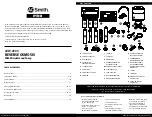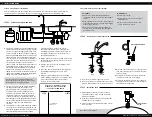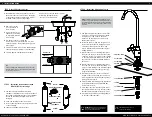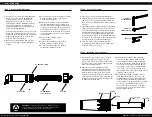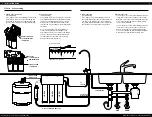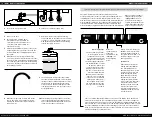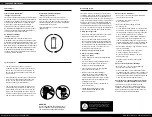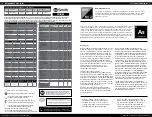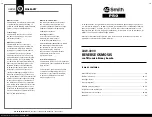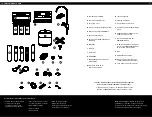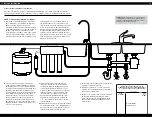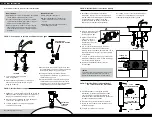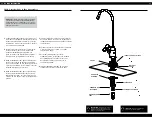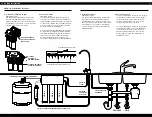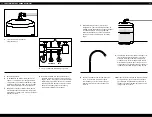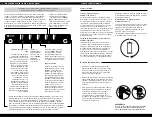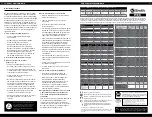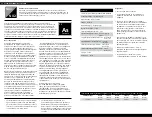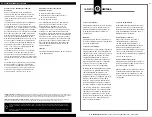
NEED HELP? GIVE US A CALL
833.232.9711
NEED HELP? GIVE US A CALL
833.232.9711
SYSTEM SPECIFICATIONS
16
AOW-4000
Replacement cartridge AOW-4000-CARBON
and AOW-4000-MEM
System Production 83.93 gpd (317 lpd)
TDS Reduction 96.7% + average
Max TDS 1000 ppm
Max water hardness 26 gpg (450 ppm)
Max Chlorine in water 3.0 ppm
Supply water pH limits 4-10
Drain (reject water) flow 1-2x product flow
Empty storage tank precharge 5-7 psi air (35-48 kPa)
Storage tank capacity 3.2 gallons (12.11 liters)
Supply water pressure limits 40-100 psi (275-689 kPa)
Supply water temp. limits 40-100 degrees F (5-37 degrees C)
Efficiency 37.64%
Recovery 47.66%
CAPACITY AT VARIOUS WATER PRESSURE LEVELS (WITH 5 PSI PRECHARGE) U.S. GALLONS
TOTAL VOLUME
20 PSI
30 PSI
40 PSI
50 PSI
60 PSI
70 PSI
3.2
1.4
1.8
2.0
2.2
2.4
2.5
NON-POTABLE WATER SOURCES:
Do not attempt to use this product to make safe drinking water from non-potable water sources. Do not use the system on
microbiologically unsafe water, or water of unknown quality without adequate disinfection before or after the system. This system is certified for cyst reduction and
may be used on disinfected water that may contain filterable cysts.
INSTALLATIONS IN THE COMMONWEALTH OF MASSACHUSETTS:
The Commonwealth of Massachusetts requires installation be performed by a licensed
plumber and does not permit the use of saddle valves. Plumbing code 248—CMR of the Commonwealth of Massachusetts must be followed in these cases.
Do not use with water that is microbiologically unsafe or of unknown water quality without adequate disinfection before or after the system.
Systems certified for cyst reduction may be used on disinfected waters that may contain filterable cysts.
Filter is only to be used with cold water. Systems certified for cyst reduction may be used on disinfected water that may contain filterable cysts.
17
Safeguards
• Use only cold water with filter.
• If you experience a hose connection
leak, disconnect and re-seat the hose.
• When you use the system for the first time,
it will flush the preservative solution from
the RO Membrane and small carbon particles
from the filter cartridges. This may cause a
slight discoloration of the water. As you flush
the system (see startup instructions), this
discoloration will end.
• It is possible for the unit to become
contaminated if it is not operated for a long
period of time. To prevent this from happening,
the system will perform an automatic flush if it
sits idle for three days.
• Disconnect the power and shut off the water
supply before fixing any leaks in the system.
• Do not allow the system to freeze. See
deactivating system in this manual.
Specifications – Qualified System Performance
Because the performance of a Reverse Osmosis
Membrane is highly dependent upon pressure,
temperature and Total Dissolved Solids (TDS),
the following should be used for comparison
purposes only.
Industry standards measure RO Membranes
performance with no back pressure on the product
water, at 60 psig (414 kPa) and 77°F (25°C). Further
conditions on the above are 250 ppm TDS and a
30.6% recovery rate. Production rate and TDS
reduction figures are for a new Membrane that
has been rinsed for 24 hours. The production rate
of a new Membrane can decrease by 10% per year
or more, depending upon the scaling and fouling
tendencies of the Feed Water.
TDS Reduction measured at 50 psi, 77°±2°F,
and 717 mg/l TDS per NSF/ANSI Standard 58.
Efficiency rating is the percentage of the influent
water to the system that is available to the
user as reverse osmosis treated water. This
measurement is taken under operating
conditions that approximate typical daily usage.
Recovery rating is the percentage of the influent
water to the membrane portion of the system that
is available to the user as reverse osmosis treated
water when the system is operated without a
storage Tank or when the Storage Tank is bypassed.
Flow rate and output are determined
by 3 factors:
1
Incoming water temperature
2
Total dissolved solids (TDS) present in
supply water
3
Incoming water pressure
Lower temperatures are directly proportional to
slower flow rate. All membranes are tested at 77°F.
Incoming water temperature should not exceed
100°F. The RO Filter System should also not be
installed in a location susceptible to freezing. The
more TDS in the supply water, the more filter time
is required. Incoming TDS should not exceed 1000
ppm. Higher water pressure enables a higher flow
rate. Pressure must be above 20 psi for proper sys-
tem operation. The system includes an
integral booster.
Cleaning
To clean your filter unit, wipe down the
exterior with a damp cloth.



